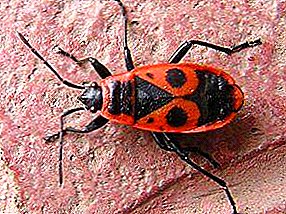 If a flower digitalis (digitalis) characterized by several epithets, then we can say that it is amazing, fabulous and even a little mystical. But she sunk into the soul not only of characters from legends and tales, but also real gardeners. For a long time, digitalis has become a real decoration of flowerbeds and gardens. Planting foxglove and care for it, as a rule, do not cause difficulties. The main thing is to follow simple agrotechnical rules.
If a flower digitalis (digitalis) characterized by several epithets, then we can say that it is amazing, fabulous and even a little mystical. But she sunk into the soul not only of characters from legends and tales, but also real gardeners. For a long time, digitalis has become a real decoration of flowerbeds and gardens. Planting foxglove and care for it, as a rule, do not cause difficulties. The main thing is to follow simple agrotechnical rules.
Planting foxglove on seedlings
Seedlings of this flower culture on garden beds should be planted in late spring or with the onset of summer. During periods when the soil is optimally heated. If it was decided to sow the seeds for seedlings in August or September, then it is more expedient to leave the seedlings to wait for the next spring on a warmed balcony.
Sowing seeds for seedlings
In order to plant foxglove on seedlings in the future to justify itself with remarkable results on germination, it is necessary to conduct it in March, closer to mid-April. Prepare in advance wooden boxes for future sowing of seeds, soil substrate and the seeds of digitalis themselves. Planting seeds should be carried out superficially, and then covered with a layer of sand.
 To ensure the greenhouse effect, wooden containers should be tightly covered with a film or pressed with glass, and then put in a warm place with diffused daylight. You only have to regularly air an improvised greenhouse. Digitalis will give the first shoots in two weeks. And then you can already carry out a picking.
To ensure the greenhouse effect, wooden containers should be tightly covered with a film or pressed with glass, and then put in a warm place with diffused daylight. You only have to regularly air an improvised greenhouse. Digitalis will give the first shoots in two weeks. And then you can already carry out a picking.
Seedling care
Care for sprouting seeds should include regular watering and mandatory feeding. Seedlings can be fertilized five days after transplanting them to a permanent place. The first dressing - ammonium nitrate 15 grams of powder should be diluted in a bucket of water - per one square meter. The following feedings will already contain complex mineral fertilizers once every ten days. It is necessary to mulch the soil for the full development of seedlings. So they will not lag behind in development and will not remain dwarfs.
Hardening seedlings
Hardening seedlings need when the temperature outside rises above 12 degrees. Plants can already gradually get used to sunlight and heat. Approximately a couple of days before planting in open ground, digitalis seedlings need to be fed with potassium, nitrogen and phosphate fertilizers of high concentration.
 This is necessary for the early engraftment of the seedlings in a new place. The first “appearance” of digitalis is held for four hours in drawers, the second - by six. The third time the plants can be left on the open balcony during the day. The longer the hardening of digitalis will take place, the stronger and more viable will be the adult plant. For greater confidence, you can continue hardening already in the open air at the summer cottage: placing the foxglove in boxes under the sun, bring it to shelter for the night.
This is necessary for the early engraftment of the seedlings in a new place. The first “appearance” of digitalis is held for four hours in drawers, the second - by six. The third time the plants can be left on the open balcony during the day. The longer the hardening of digitalis will take place, the stronger and more viable will be the adult plant. For greater confidence, you can continue hardening already in the open air at the summer cottage: placing the foxglove in boxes under the sun, bring it to shelter for the night.
Ten days before planting, reduce the number of waterings, and a week to stop it completely. On the day of disembarkation, pour plenty of water on the seedlings with the addition of potassium chloride in the amount of 30 grams per bucket of water.
Did you know? It is said that digitalis was previously popular with witches. For this, he is in the people and got its name "witches thimbles", less often "witch finger".
Planting seedlings in open ground
Let digitalis and a very resistant flower that tolerates wintering and dry summer periods well, but still you need to know the requirements for choosing a place for a plant in a garden. Their observance will allow to grow magnificent and beautiful ornamental bushes with bright flowers.
Dates and choice of place for landing
 You can plant digitalis in open ground, when the threat of sudden night frosts has passed, that is, in late May - early June. By this time, the soil will warm up well, and the seedlings will acquire five or six leaves. Penumbra is excellent for foxglove, although it grows best in sunny areas. It should not be planted under deciduous trees, because excessive moisture lasts longer in their tree trunks, and in October-November, the fallen leaves interfere with digitalis.
You can plant digitalis in open ground, when the threat of sudden night frosts has passed, that is, in late May - early June. By this time, the soil will warm up well, and the seedlings will acquire five or six leaves. Penumbra is excellent for foxglove, although it grows best in sunny areas. It should not be planted under deciduous trees, because excessive moisture lasts longer in their tree trunks, and in October-November, the fallen leaves interfere with digitalis.
Soil preparation and planting procedure
Ideal soil for foxglove - loose, fertile and well drained. Before planting seedlings need to dig up the soil with the introduction of five kilograms of compost or humus per square meter. It is necessary to plant a foxglove 20 centimeters from each other, the distance between the rows is 30 centimeters. The holes for seedlings must be larger than the size of the root system. Earth lump of individual cups or a common box sketched there.
Later the plot needs to be compacted and watered well. The foxglove begins to bloom only in the second year, and in the first year of life it only forms a leafy rosette.
Combination with other plants
Low forms of foxglove allow to decorate areas along fences and walls. The most undersized varieties make out garden paths and borders. With the help of high copies create bright original backgrounds of linear flower beds and mixborders. They are planted in the central and back rows of mixed flower beds. Large flowers look favorably in stand-alone potting compositions and garden decorative pots. Remarkably, digitalis are combined with a variety of plants.
You can also create composite mixes:
- Universal - irises, peonies, aquilegia, ornamental bow, angelica, garden geraniums;
- Shade tolerant - primroses, geraniums, hosts;
- Forest trees, shrubs - honeysuckle, dog rose, rhododendron, viburnum;
- Decorative perennials suitable for natural gardens - valerian, astilba, rododersia, dissentra, geykhera, allium and others.
 Clearly formed vertical lines of peduncles of digitalis emphasize those plants in which nature has formed large ornamental leaves, such as Brunner. Free group plantings of foxgloves of different widths and heights are successfully used in natural gardens. The natural glade of the most decorative foxgloves always looks relevant and romantic in every corner of the garden. Large panicles of bright color create spectacular bouquets, retain freshness in bouquets for a long time.
Clearly formed vertical lines of peduncles of digitalis emphasize those plants in which nature has formed large ornamental leaves, such as Brunner. Free group plantings of foxgloves of different widths and heights are successfully used in natural gardens. The natural glade of the most decorative foxgloves always looks relevant and romantic in every corner of the garden. Large panicles of bright color create spectacular bouquets, retain freshness in bouquets for a long time.
Seeding of foxglove seeds on the garden bed
The success of digitalis sowing is a properly chosen area and regular care. Digitalis grows in any soil, but light soil with good fertile properties will be preferable. Before sowing, you need to completely dig up the area and level its surface.
Water and sow the seeds. Furrows can not be formed, as the seeds are laid out on the ground surface. You just need to visually mark the ridge. Seedlings spread out sparsely, so that they do not have to then dive off shoots. After planting the seedlings they need to sprinkle with a thin sandy layer. Cover the site with special material and additionally pritenit. Cultivation of foxgloom is reduced to moderate watering before the first shoots. The first sprouts will appear in 14-18 days. A week later there will be a couple of leaves.
If the planting is thickened, the sprouts will need to dive or thin out, leaving the distance between the plants of about ten centimeters. If dive seedlings were planted in the ground, the repeated procedure should be carried out in another two weeks. All this time, the beds should be watered, loosened and pulled on them weeds.
Important! Any medicinal use of digitalis can be fatal without the necessary knowledge. All species of this plant are poisonous.
Reproduction of foxglove with basal processes
 At the base of the plant, several basal rosettes appear. When they give eight leaves, sockets must be carefully separated from the parent plant and landed in a prepared place. After transplantation and subsequent watering, make sure that water and soil do not fall into the outlet. Otherwise, the plant may die. At the end of the summer, the flowers will take root, grow stronger and prepare for wintering with adult cultures.
At the base of the plant, several basal rosettes appear. When they give eight leaves, sockets must be carefully separated from the parent plant and landed in a prepared place. After transplantation and subsequent watering, make sure that water and soil do not fall into the outlet. Otherwise, the plant may die. At the end of the summer, the flowers will take root, grow stronger and prepare for wintering with adult cultures.
Features care for flowers in the garden
Caring for an adult digitalis in the garden should include the following procedures:
- Regular watering
- Soil loosening
- Hilling
- Weeding
- Top dressing
- Protection against pests and diseases.
Water regularly and plenty of water. The main thing is to choose the right site. The soil should be light and well drained. Digitalis can grow in areas with abundant lighting and in the shade. Adult digitalis should be fed every seasonally three times a day. By the end of the season, the roots of the plant may become bare because of the abundant watering, so they need to spud.
Preparing a perennial foxglove for winter
 Digitalis - very cold-resistant flowers. So that they comfortably tolerate frosts, they are covered with fallen leaves or branches. Keep track of the condition of the roots that were exposed at the end of the summer season. They should be tightly sprinkled with earth, so that they do not freeze. Copies of foxglove, who endured the winter in a cool room, while in pots, are exposed on the street in early spring. Already in April, you will be able to observe their magnificent bloom.
Digitalis - very cold-resistant flowers. So that they comfortably tolerate frosts, they are covered with fallen leaves or branches. Keep track of the condition of the roots that were exposed at the end of the summer season. They should be tightly sprinkled with earth, so that they do not freeze. Copies of foxglove, who endured the winter in a cool room, while in pots, are exposed on the street in early spring. Already in April, you will be able to observe their magnificent bloom.
Did you know? On cold nights, the flowers of digitalis become a haven for insects. At night, the temperature inside it is much higher than the environment. Leaving the flower, the insects spread the pollen. Thus pollinated plants.
Diseases and pests control
The most frequent diseases affecting digitalis are rot, spotting, powdery mildew and viral mosaic. If the plant is severely affected by powdery mildew and spotting, it must be destroyed and the rest treated with fungicides. In the diagnosis of viral diseases, such as mosaic, root rot and decay of the peduncle, the plant is also removed and burned.
 There is no treatment, only preventive measures are needed. The most common pest of digitalis is aphid. Digitalis needs to be processed with "Biotlin", "Antitlin" and "Iskra". Aphid also carries incurable viral diseases, so you need to immediately respond to its appearance. But in general, planting foxglove and care for it does not cause much trouble.
There is no treatment, only preventive measures are needed. The most common pest of digitalis is aphid. Digitalis needs to be processed with "Biotlin", "Antitlin" and "Iskra". Aphid also carries incurable viral diseases, so you need to immediately respond to its appearance. But in general, planting foxglove and care for it does not cause much trouble.












